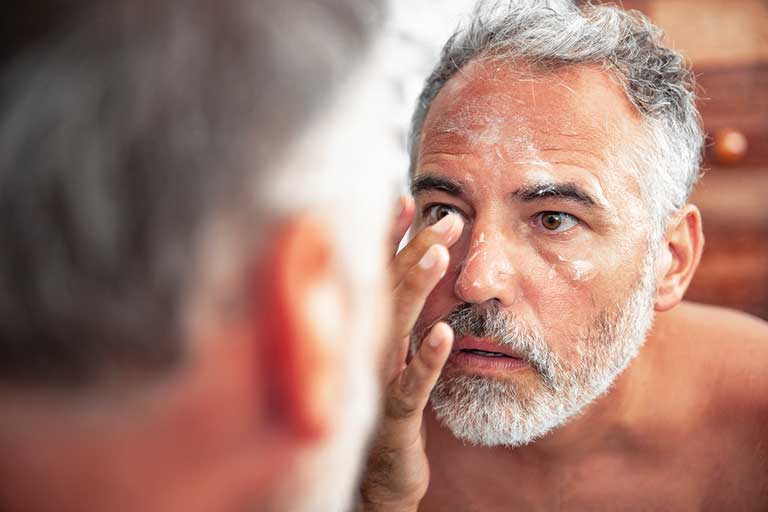All about Actinic keratosis
Actinic keratosis is an area of the skin damaged by ultraviolet radiation that appears in zones exposed to the sun for years. Its appearance is variable.

Tips to prevent actinic keratosis
Ultraviolet (UV) radiation emitted by the sun and other UV radiation sources is the main cause of actinic keratosis. Thus, adequate protection from this radiation is the best method to prevent the occurrence of actinic kearatosis. Also, sunscreen can help reduce or eliminate actinic keratoses already present in your skin.
But, how can I protect myself adequately? here is how:

- Use sunscreen daily. Apply sunscreen every day of the year, whether you go for a hike in the mountains or if you only intend to take a walk through your town or city: remember that chronicity in UV exposure plays a key role in the development of actinic keratosis. Also keep in mind that, even it is cloudy, UV radiation can still be high.
Choose a broad-spectrum sunscreen to protect you against various types of radiation with a high protection factor (SPF 30 or higher); The whiter your skin is, the stronger protection factor you will need. Apply it 15 minutes before sun exposure and reapply every 2 hours or more frequently if you are in the water or do sports and sweat. In these cases, it is preferable to use water-proof sunscreen. Choose one with a pleasant texture and suitable for your needs. This will make it easier for you to apply. Your dermatologist and your pharmacist can advise you on the best choice for you. - Avoid peak sun hours. Seek shady places, especially between 12 and 4 in the afternoon, when sun rays are strongest. The sand on the beach reflects 20% of the solar radiation, and hence protecting yourself under a sun umbrella as the only protective measure is not an effective solution.
- Use protective clothing. Use thick, dark-colored garments, which absorb part of the UV radiation before it reaches the skin. The darker the color, the more protection. There is also clothing with ultraviolet protection factor. Wide-brimmed hats protect both the scalp and the face, ears, neckline and part of the shoulders. The Skin Cancer Foundation recommends that all people use hats. There are also caps that, in addition to the visor, incorporate a rear extension of the fabric that covers more areas than traditional ones.
- Avoid tanning salons. Tanning lamps and tanning booths emit UV radiation harmful to the skin.
- Examine your skin regularly. Examining your own skin regularly will allow you to notice any changes. Because of their rough texture, actinic keratoses are often easier to feel than see. If you notice any suspicious changes (for instance, a new actinic keratosis lesion has appeared or one of the old ones has changed in any way, be it in size or shape or bleeds), visit your dermatologist and make an appointment to get checked right away.
References
- Werner RN, Stockfleth E, Connolly SM, et al. Evidence- and consensus-based (S3) Guidelines for the Treatment of Actinic Keratosis - International League of Dermatological Societies in cooperation with the European Dermatology Forum – Short version [Internet]. J Eur Acad Dermatol Venereol. 2015;29(11):2069-79. Available at: http://doi.wiley.com/10.1111/jdv.13180
- AAD: American Academy of Dermatology [Internet]. Rosemont, IL (USA): AAD; c2020. Actinic keratosis: Self-care; [cited 2020 Feb 20]; [approx. 3 screens]. Available at: https://www.aad.org/public/diseases/skin-cancer/actinic-keratosis-self-care
- Gohara M, Morison W, Sarnoff DS. Clothing: Our first line of defence [cited 6 February 2020]. In: The Skin Cancer Foundation [Internet]. New York (USA): The Skin Cancer Foundation; c2019. - [approx. 5 screens]. Available at: https://www.skincancer.org/skin-cancer-prevention/sun-protection/
- BAD: British Association of Dermatologists. Actinic Keratoses - Also Known as Solar Keratoses [Internet]. London (United Kingdom): BAD; 2007 May [revised 2019 nov; cited 2020 Feb 20]. 5 p. Available at: http://www.bad.org.uk/shared/get-file.ashx?id=1974&itemtype=document
Frequently asked questions about actinic keratosis
Actinic keratosis is not hereditary, although some of the factors that favor its appearance, such as fair skin or freckles, are so. Actinic keratosis is not contagious.
Actinic keratosis is an uncontrolled proliferation of keratinocytes: the most abundant cells of the epidermis (the outermost layer of the skin), that become abnormal4. Some actinic keratoses can turn into a type of skin cancer called epidermoid carcinoma or invasive squamous cell carcinoma1,4. Although rare, this type of cancer can spread to other tissues, and it is therefore recommended to treat all actinic keratoses.
Furthermore, a person with actinic keratosis is at higher risk of developing any type of skin cancer compared to another person of the same age who does not. People who have a higher number of actinic keratoses also run a higher risk of skin cancer.
Some actinic keratoses resolve spontaneously, especially if sunscreen or protection is used, although most remain as they are. Others may progress into invasive squamous cell carcinoma. Unfortunately, it is impossible to know in advance which ones will in fact progress into invasive squamous cell carcinoma. The clinical course of the condition cannot be predicted.
Actinic keratosis lesions can heal and disappear spontaneously or through treatment. However, it is very common for old lesions to recur or for new ones to come out. The presence of a single actinic keratosis is already a sign that chronic damage from solar radiation has occurred, and hence there is a risk that other lesions could appear. Therefore, if you have actinic keratosis, your doctor will monitor you regularly, and will recommend that you seek consultation if you notice new lesions or any changes in the ones you already have.
Protecting yourself from the sun is essential to prevent the appearance of actinic keratosis and slow down progression. Following the following measures strictly is key to keeping actinic keratoses under control:
Use sunscreen and clothing that covers your body.
- Avoid peak sun hours.
- Avoid artificial sunlight (sun beds/tanning salons).
- Check your skin at home and schedule an appointment with the dermatologist on a regular basis.
